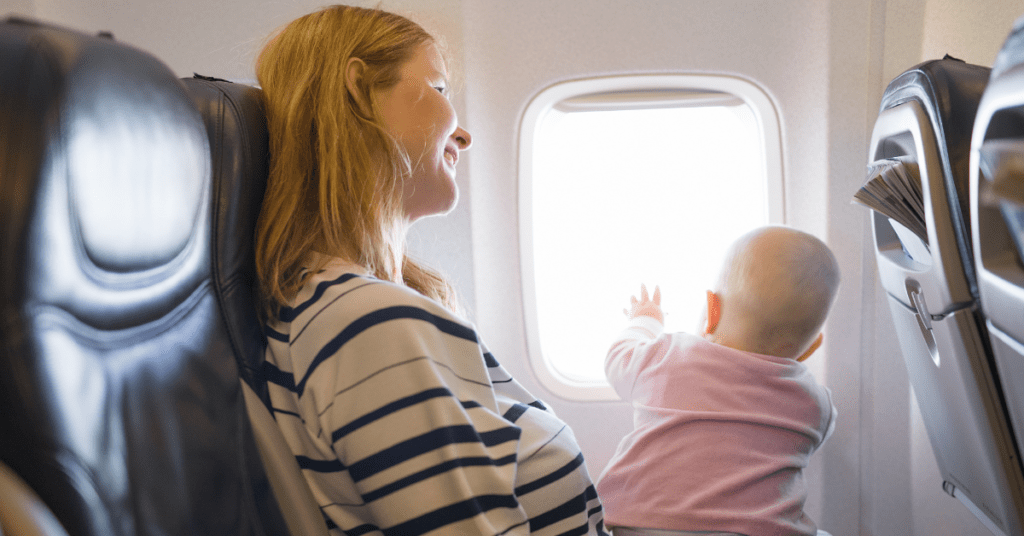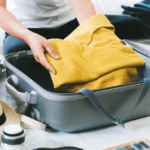Traveling with an infant by air can be challenging, but with proper planning and preparation, it can be made more manageable. Here are some essential tips for air travel with infants.
As a parent, being well-prepared and organized prior to the flight is key. Being proactive and anticipating your infant’s needs will help ensure a smoother journey. From packing the right essentials to choosing the most convenient flight times. These tips will help you navigate air travel with your baby with ease.
Additionally, knowing the airline’s policies and being familiar with airport facilities for families will also contribute to a stress-free travel experience. With these tips in mind, you can approach air travel with your infant with confidence and ease.
Preparing For Air Travel With Infants
Traveling with an infant can be daunting, but preparation is key. Remember to pack enough supplies, like diapers, formula, and extra clothes. Try to book a flight during nap time and bring toys or snacks to keep your little one entertained.
Additionally, consider bringing a baby carrier to keep your hands free.
Understanding Airline Policies For Infant Travel
Before embarking on air travel with your infant, it’s crucial to familiarize yourself with the specific policies of the airlines you’ll be flying with. Ensure you carefully check the guidelines concerning infant tickets, carry-on allowances, and any additional services or amenities provided for families traveling with young children. This information will help you navigate the booking process more efficiently and ensure a smooth travel experience.
Choosing Flights With Infant-friendliness In Mind
When selecting flights for your journey, prioritize carriers and routes that are renowned for their infant-friendly services and facilities. Consider factors such as convenient departure and arrival times, the availability of bassinets or infant seats, and any special accommodations for nursing mothers. This careful consideration can significantly contribute to minimizing the stress and discomfort often associated with air travel with infants.
Packing Essentials For Infant Comfort And Needs
In preparing for air travel with your infant, ensure you meticulously pack all the essentials to cater to their comfort and needs throughout the journey. Remember to include items such as baby food, diapers, wipes, baby blankets, and a change of clothes in your carry-on luggage. Additionally, consider bringing along comforting toys or pacifiers to help soothe your baby during takeoff and landing. Prioritize their comfort and well-being by preparing a well-stocked diaper bag to address any potential needs during the flight.
Essential Documents And Procedures
When traveling with infants, it’s vital to ensure you have all the essential documents and are familiar with the necessary procedures to make the journey as smooth as possible. Here are some crucial steps to take when it comes to essential documents and procedures for air travel with infants.
Gathering Necessary Identification For Infant Air Travel
When preparing for air travel with your baby, it’s important to gather all the required identification documents. You’ll typically need your child’s birth certificate to verify their age. For domestic flights, some airlines may allow you to use a copy, but for international travel, an original document is usually required. Additionally, ensure you have your infant’s passport if you are traveling internationally. Also, it’s always a good idea to carry a photocopy as a backup. Check with the specific airline for any additional documentation requirements to avoid any last-minute hassles.
Familiarizing With Airport Security Protocols For Babies
Before heading to the airport, familiarize yourself with the security procedures and protocols for traveling with infants. Be aware that you may need to remove your baby from their carrier or stroller when passing through the security checkpoint. Packing strategically can help expedite the process, so have essential items easily accessible and use a baby carrier that is easy to put on and take off. Rules and procedures may vary between airports and countries. It is advisable to check the specific guidelines of the airports you will be traveling through in advance.
Booking Tips For Infant-friendly Seats
When it comes to air travel with infants, booking the right seats can make a world of difference in ensuring a smooth and comfortable journey for both you and your little one. From extra legroom to proximity to the bassinet positions. Here are the essential tips for securing infant-friendly seats on your next flight.
Selecting The Best Seats For Space And Convenience
When booking your flights, look for seats that provide ample space for you to move about with your infant. Bulkhead seats are often a popular choice, as they offer more legroom and often have a convenient wall-mounted bassinet cradle. Additionally, aim for seats near the aisle for easy access to the lavatory and to allow for easier movement during the flight.
Considerations For Bassinet Positions On Long-haul Flights
If you’re embarking on a long-haul journey, securing a bassinet position can greatly enhance your comfort and your baby’s well-being. Requesting a bassinet position early on in the booking process is crucial, as these seats are limited and in high demand. Keep in mind that not all aircraft are equipped with bassinets. So it’s essential to check the availability of this feature when selecting your seats.
Efficient Packing For Infant Air Travel
Efficient Packing for Infant Air travel is crucial for a smooth and stress-free journey. Traveling with an infant can be challenging, but with the right organization and packing strategy. You can make the experience more manageable for both you and your little one. From streamlining diapers, formula, and baby food for the flight to packing must-have items in your carry-on for easy access, efficient packing is essential.
Streamlining Diapers, Formula, And Baby Food For The Flight
- Pack disposable diapers in a zip-top bag to keep them compact and easily accessible during the flight.
- Consider using travel-sized packs of wipes to save space in your carry-on.
- Opt for a pre-measured formula in individual packets or a formula dispenser to minimize the bulk and avoid spills.
- For baby food, choose squeeze pouches or small, lightweight containers to minimize the need for bulky jars or cans.
Must-have Items In Your Carry-on For Easy Access
- A changing pad to create a clean and hygienic surface when changing diapers on the go.
- Extra outfits for both you and your baby in case of spills or accidents
- Comfort items such as a favorite toy or blanket to help soothe your infant during the flight
- Snacks and feeding supplies will keep your baby satisfied and well-fed throughout the journey.
Navigating Airports With A Baby
Traveling through airports with an infant can seem like a daunting task, but with the right strategies and facilities, it can be a smooth experience. From utilizing family-friendly airport facilities to managing layovers with ease, Here are some tips for navigating airports with a baby.
Utilizing Family-friendly Airport Facilities
Finding family-friendly facilities at airports can make a significant difference in the comfort and convenience of air travel for an infant. Many airports offer designated nursing rooms equipped with comfortable seating, changing tables, and privacy for feeding or changing your baby. Look for these facilities when planning your airport route to ensure you have access to them during your layovers or wait times. Additionally, some airports provide stroller rentals or designated play areas where older infants and toddlers can burn off some energy before a flight.
Strategies For Managing Layovers With Infants
When facing layovers with an infant, strategic planning is essential for a smooth experience. Consider researching the layout of the airport in advance to identify quiet spaces or areas where you can take your baby for a peaceful break. Utilize layover time for diaper changes, feeding, and allowing your baby to stretch and move around. Packing a small travel bag with essential items such as diapers, wipes, a change of clothes, and favorite toys can help you manage layovers without feeling overwhelmed. If possible, try to book flights with longer layovers, giving you ample time to navigate the airport at a comfortable pace with your little one.
Credit: www.verywellfamily.com
Calming Infants During Takeoff And Landing
Air travel with infants can be challenging, especially during takeoff and landing, when changes in air pressure can cause discomfort. It’s essential to have strategies in place to calm infants during these critical moments to ensure a smoother and more pleasant journey for both the baby and the parents. Let’s explore some effective techniques and activities to alleviate ear pressure discomfort and keep the little ones calm during takeoff and landing.
Techniques To Soothe Ear Pressure Discomfort
- Feeding: Nursing or providing a bottle during takeoff and landing can help alleviate ear pressure by swallowing, which helps equalize the pressure in the infant’s ears.
- Pacifiers: Encouraging infants to suck on a pacifier can also aid in relieving ear pressure and providing comfort.
- Gentle Patting: Gently patting or rubbing the infant’s back can offer a soothing distraction and help alleviate ear discomfort.
Engaging Activities To Distract And Calm Infants
- Interactive Toys: Bringing along interactive toys, such as soft rattles or colorful teething accessories, can captivate the infant’s attention and provide a welcome distraction.
- Singing or Humming: Singing or softly humming a familiar and soothing tune can help reassure and calm the infant during the changes in air pressure.
- Visual Stimulation: Showing the infant colorful pictures or a baby-friendly book can engage their senses and divert their attention from the discomfort of ear pressure changes.
Ensuring Infant Safety And Comfort Onboard
Traveling with an infant can be challenging, especially when it comes to ensuring their safety and comfort throughout the flight. From using appropriate infant restraints to adjusting the cabin environment, there are several measures that can be taken to make air travel with infants a more pleasant experience for both the baby and the parents.
Using Appropriate Infant Restraints During The Flight
When traveling with an infant, it is crucial to use the appropriate restraints to ensure their safety during the flight. Airlines often provide options for infant restraints, such as bassinets, infant seat belts, or approved child restraints. Securing the infant in a designated restraint can greatly reduce the risk of injury during turbulence or unexpected events. It’s important to follow the guidelines provided by the airline and ensure that the restraint is properly secured before takeoff.
Adjusting the cabin environment for infants well-being
Creating a comfortable cabin environment is essential for the well-being of the infant during the flight. Regulating the temperature to keep the infant at a comfortable level and ensuring proper airflow is crucial. Additionally, minimizing noise and light disturbances can help the infant relax and possibly sleep during the flight. If possible, selecting seating near the bulkhead can provide additional space and privacy for caring for the infant.
Feeding Infants While Flying
Feeding infants while flying can be a challenging task, but with the right strategies, it can be made easier. Timing feeding schedules with flight routines and understanding the nuances of breastfeeding or bottle-feeding at altitude are key considerations for a smooth travel experience.
Timing Feeding Schedules With Flight Routines
Ensuring that your infant is well fed before boarding the flight can help manage their feeding schedule during the journey. It’s wise to feed your infant shortly before the flight to minimize the need for feeding during takeoff and landing, which can help alleviate discomfort due to changes in air pressure.
Tips For Breastfeeding And Bottle-feeding At Altitude
When it comes to breastfeeding or bottle-feeding at altitude, there are some considerations to keep in mind to ensure your infant’s comfort:
- Offer the breast or bottle during ascent and descent to help equalize ear pressure.
- Use a baby carrier or sling to provide a comfortable and discreet environment for breastfeeding.
- Ensure that formula bottles are properly sealed to prevent leaks due to changes in air pressure.
- Consider bringing expressed breast milk or a pre-portioned formula to simplify feeding on the plane.
Managing Sleep For Infants On Planes
When it comes to air travel with infants, managing their sleep on planes can be a challenge. However, with the right strategies, you can help ensure a smoother journey for both you and your little one. Here are some tips for managing sleep for infants on planes.
Encouraging Sleep With Familiar Routines And Items
One way to help your infant sleep on a plane is to recreate their familiar sleep environment as much as possible. This could include bringing along their favorite blanket, pacifier, or stuffed animal. Stick to their usual bedtime routine as much as possible, whether it’s reading a book or singing a lullaby, to signal that it’s time to sleep.
Adapting To Time Zones And Jet Lag With Infants
Traveling across different time zones can disrupt your infant’s sleep schedule. To minimize the impact, try adjusting your baby’s routine gradually a few days before the trip to align with the new time zone. Once on the plane, try to maintain a dark and quiet environment to mimic their regular sleep conditions.
Mitigating Health Concerns And First Aid
Ensure a smooth air travel experience with your infant by planning ahead. Keep essential first-aid items on hand, such as baby pain relievers and fever reducers. Additionally, mitigate health concerns by packing sufficient diapers, wipes, and sanitizer.
Preventing Common Health Issues During Air Travel
Air travel with infants can present unique health challenges due to changes in air pressure and confined environments. It’s essential to take preventive measures to ensure a comfortable and safe journey for your little one.
- Keep your infant hydrated: The dry air in flight cabins can lead to dehydration, so make sure to offer frequent feedings or sips of water to keep your baby hydrated.
- Protect their ears: Encourage swallowing during takeoff and landing by offering a pacifier or breastfeeding to help alleviate ear pressure.
- Dress in layers: Fluctuating cabin temperatures can make it challenging to regulate your baby’s body temperature, so dress them in comfortable layers that can be easily adjusted.
- Sanitize surfaces: wipe down tray tables, armrests, and other surfaces with baby-safe disinfectant wipes to minimize exposure to germs.
Baby First Aid Essentials To Pack For Emergencies
Being prepared for potential emergencies during air travel is crucial. Packing the right first aid items can provide peace of mind and ensure you can address any minor health issues that may arise. To read travel health tips.
- Digital thermometer: A reliable digital thermometer can help you monitor your baby’s temperature if they become unwell.
- Saline nasal spray: A gentle saline solution can help clear your baby’s nasal passages if they experience congestion during the flight.
- Baby pain relief medication: Packing infant-friendly pain relief medication, such as paracetamol or ibuprofen, can help alleviate discomfort in cases of fever or minor aches.
Frequently Asked Questions For Tips For Air Travel With Infants
How Can I Protect My Baby’s Ears While Flying?
To protect your baby’s ears while flying, consider using earplugs or noise-canceling headphones. Breastfeeding or giving a pacifier during takeoff and landing can also help. Be sure to check with your pediatrician for any additional suggestions.
How Do I Prepare My Baby for a Flight?
To prepare your baby for a flight, pack essentials like diapers, formula, and toys. Feed and burp your baby before takeoff to avoid discomfort. Dress your baby in comfortable clothing. Consider using a baby carrier for convenience. Arrive early to allow time for security and boarding.
What Do I Need to Know When Flying With an Infant?
When flying with an infant, remember to bring essential items like diapers, bottles, and extra clothes. Verify airline policies for stroller and car seat usage. Book a bassinet if available, and prepare to feed or comfort your baby during takeoff and landing.
Check the TSA guidelines for carrying baby items.
What Are the Rules for Infants Traveling by Air?
Infants traveling by air must have a ticket or sit on a parent’s lap. Some airlines offer bassinets for infants under 6 months. It’s advisable to carry a stroller and baby supplies. Check with the airline for their specific rules.
Always carry necessary documents, such as a birth certificate and ID.
Conclusion
Traveling with infants may seem daunting, but with careful planning and organization, it can be a smooth and enjoyable experience for both you and your little one. By following the tips discussed in this post, you can optimize your air travel experience and create lasting memories with your baby.
Safe travels!


